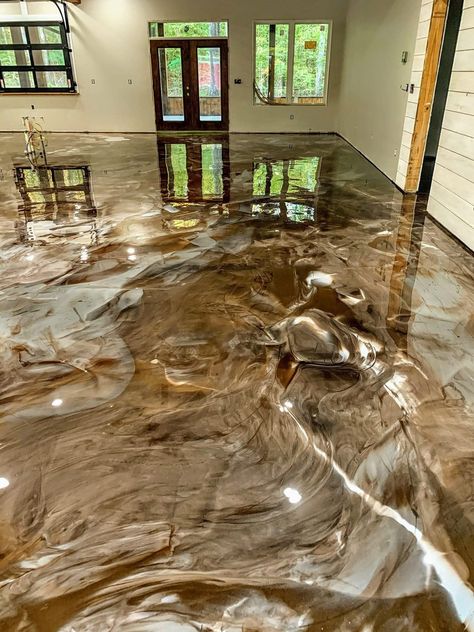Epoxy flooring is revolutionizing interior design, offering both durability and style in residential and commercial spaces alike. Whether you’re renovating your home or updating a business environment, epoxy flooring presents a versatile and practical solution that enhances the aesthetic appeal while providing long-lasting protection. Here’s everything you need to know about how epoxy flooring can transform your space.
What is Epoxy Flooring?
Epoxy flooring is a type of surface coating that consists of multiple layers of epoxy applied to a floor with a depth of at least two millimeters. It is composed of resins and hardeners that chemically react to form a rigid plastic material. This chemical reaction creates a strong bond that adheres to the substrate, resulting in a durable and resilient flooring surface.
Durability: A Long-lasting Investment
One of the primary benefits of epoxy flooring is its exceptional durability. Once applied, epoxy creates a surface that is highly resistant to impacts, stains, chemicals, and surface abrasion. This durability makes it ideal for high-traffic areas such as garages, warehouses, industrial facilities, and retail spaces where floors undergo constant use and wear.
Epoxy floors can withstand heavy machinery, foot traffic, and various environmental factors without losing their integrity. This makes them a cost-effective long-term investment, as they require minimal maintenance and have a longer lifespan compared to traditional flooring materials like tile or carpet.
Enhancing Style: Versatility in Design
Beyond its durability, epoxy flooring offers unmatched versatility in terms of design. Available in a wide range of colors, patterns, and finishes, epoxy can be customized to complement any interior aesthetic. Whether you prefer a sleek, modern look for a residential kitchen or a professional, polished appearance for a showroom, epoxy flooring can be tailored to meet your specific design goals.
Popular options include metallic epoxy finishes that create a three-dimensional effect with swirls of color, as well as solid colors for a clean and uniform appearance. Epoxy can even mimic the look of natural materials such as marble or granite at a fraction of the cost.
Installation Process: Precision and Expertise
Installing epoxy flooring requires precision and expertise to achieve optimal results. The process typically involves several steps:
- Surface Preparation: Proper preparation of the substrate is crucial to ensure the epoxy adheres securely. This may involve cleaning, repairing cracks or imperfections, and possibly etching the surface to promote adhesion.
- Primer Application: A primer coat is applied to the prepared surface to enhance bonding between the substrate and the epoxy layers.
- Epoxy Application: The epoxy mixture is carefully applied to the primed surface. Depending on the desired thickness and finish, multiple coats may be applied.
- Topcoat Application: A clear topcoat is often applied to provide additional protection against abrasion, UV rays, and chemical spills. This topcoat also enhances the gloss and durability of the epoxy flooring.
- Curing: Proper curing time is essential to allow the epoxy to harden and achieve its full strength. Curing times can vary depending on environmental conditions such as temperature and humidity.
Maintenance and Care
Once installed, epoxy flooring requires minimal maintenance compared to other flooring options. Regular cleaning with a mild detergent and water is usually sufficient to keep the surface looking new. Avoiding abrasive cleaners and waxing the surface periodically can help maintain its shine and protective properties over time.
In high-traffic areas, routine inspections and occasional touch-ups may be necessary to address any wear and tear. However, the overall maintenance requirements are significantly lower compared to materials like hardwood or carpet.
Environmental Considerations
Epoxy flooring is known for its eco-friendly properties, especially when compared to traditional flooring materials. Its durability and longevity reduce the need for frequent replacements, minimizing waste and conserving resources. Additionally, epoxy coatings can be formulated to emit low levels of volatile organic compounds (VOCs), making them a safer choice for indoor air quality.
Cost Considerations
The cost of epoxy flooring varies depending on factors such as the size of the area, complexity of the installation, and the chosen design options. While epoxy flooring may have a higher upfront cost compared to some traditional materials, its durability and low maintenance requirements often result in long-term cost savings. It is important to consider epoxy flooring as an investment in the value and longevity of your space.
Applications of Epoxy Flooring
Epoxy flooring is suitable for a wide range of applications across different sectors:
- Residential: Ideal for garages, basements, kitchens, and living areas where durability and aesthetic appeal are desired.
- Commercial: Popular in retail stores, restaurants, hospitals, and offices for its ability to withstand heavy foot traffic and enhance the overall environment.
- Industrial: Used in warehouses, manufacturing facilities, and production areas where resistance to chemicals, abrasion, and impact is essential.
Conclusion
Epoxy flooring offers a compelling combination of durability, style, and practicality for both residential and commercial spaces. Whether you’re looking to upgrade your home’s interior or enhance the functionality of your business environment, epoxy flooring provides a versatile solution that meets the demands of modern living and working. With its wide range of design options and long-lasting performance, epoxy flooring stands out as a superior choice for transforming your space into a durable and visually appealing masterpiece.

